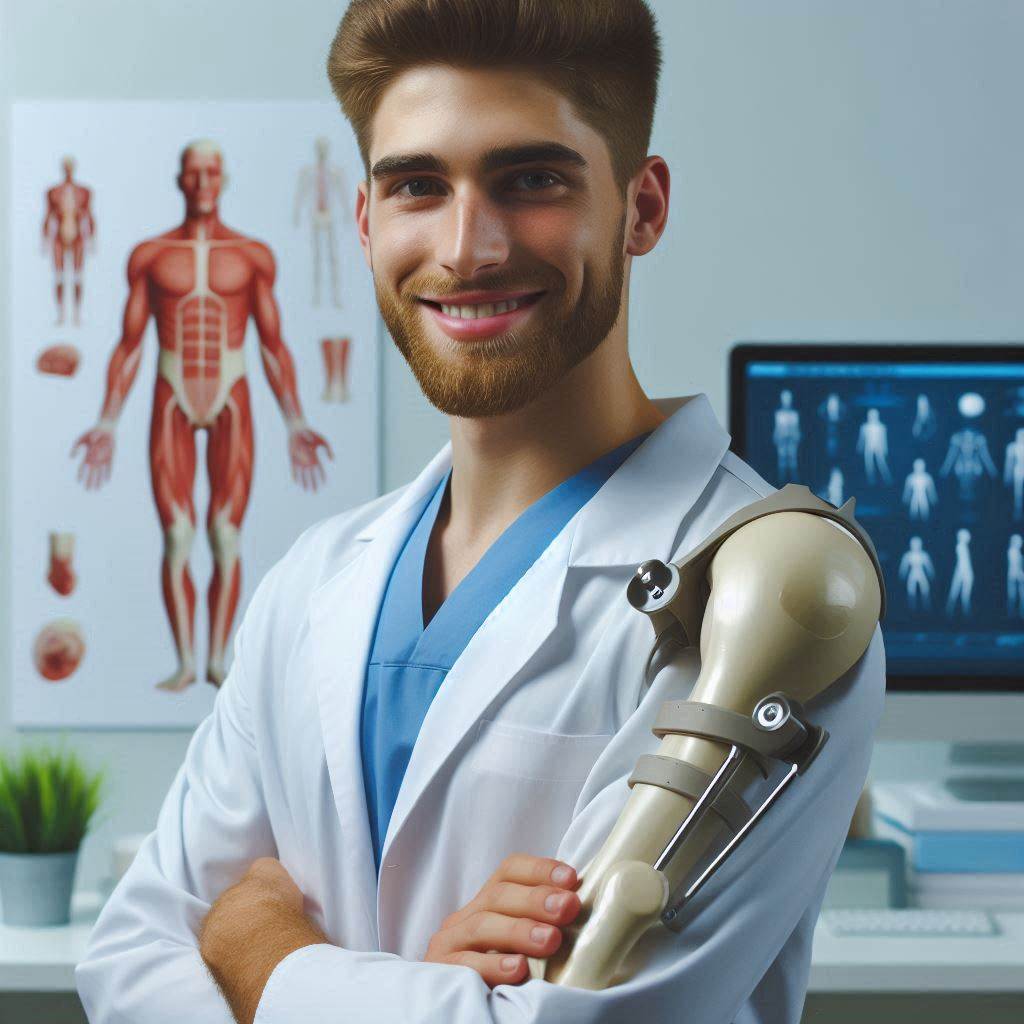Introduction
How Technology is Transforming Orthotics and Prosthetics: Orthotics and prosthetics are critical medical devices designed to support and enhance the function and mobility of individuals with physical impairments.
Orthotics refers to external devices used to support, align, or correct musculoskeletal deformities and imbalances, while prosthetics are artificial limbs that replace missing body parts.
In recent years, technology has significantly impacted this field, leading to advancements that are revolutionizing patient care.
From 3D printing to smart devices, technology is transforming orthotics and prosthetics, making them more effective, personalized, and accessible.
This blog post will explore how cutting-edge technologies are enhancing the design, production, and functionality of orthotic and prosthetic devices, ultimately improving the quality of life for patients.
One of the most significant technological advancements in orthotics and prosthetics is the use of 3D printing.
This technology allows for precise customization of devices to fit the unique anatomy of each patient.
3D scanning and printing enable the creation of orthotics and prosthetics that are not only more comfortable but also more functional.
Advancements in 3D printing technology
Utilizing 3D Printing for Custom Orthotic and Prosthetic Devices
3D printing technology has revolutionized the field of orthotics and prosthetics by allowing for the creation of custom devices tailored to each individual’s unique anatomy.
Traditional methods often involved manual fabrication, which could be time-consuming and imprecise.
With 3D printing, a digital scan of the patient’s limb or body part can be directly translated into a three-dimensional model, which serves as the blueprint for the orthotic or prosthetic device.
Benefits of 3D Printing in Orthotics and Prosthetics
One of the key advantages of 3D printing in orthotics and prosthetics is the ability to produce devices more quickly and with greater accuracy.
This means that patients can receive their custom-fitted devices in a fraction of the time it would take using traditional methods.
Additionally, the level of customization provided by 3D printing ensures a more precise fit, leading to improved comfort and functionality for the wearer.
Successful Applications of 3D Printing in Orthotics and Prosthetics
There have been numerous successful applications of 3D printing in the field of orthotics and prosthetics.
For example, companies like UNYQ have utilized 3D printing technology to create stylish and personalized prosthetic covers that allow amputees to express their individuality.
Additionally, researchers have developed 3D-printed orthotic devices for patients with conditions such as scoliosis, providing a more comfortable and effective treatment option.
Read: Public Health Administrator vs. Health Services Manager
Use of robotics in orthotic and prosthetic devices
Overview of how robotics are being integrated into orthotic and prosthetic devices to enhance functionality
The integration of robotics into orthotic and prosthetic devices is revolutionizing the field, offering unprecedented enhancements in functionality and user experience.
Robotics technology is being incorporated into these devices to improve mobility, precision, and overall quality of life for users.
Transform Your Career Today
Unlock a personalized career strategy that drives real results. Get tailored advice and a roadmap designed just for you.
Start NowThis transformation is marked by the development of sophisticated robotic limbs and orthotic supports that adapt to the user’s movements and needs.
The benefits of robotic technology, such as improved mobility for users
One of the key benefits of robotic technology in orthotics and prosthetics is the significant improvement in mobility it provides.
Traditional prosthetics and orthotic devices, while functional, often lack the dynamic adaptability that robotic systems offer.
Robotic prosthetics, for instance, are equipped with sensors and microprocessors that mimic natural limb movements, enabling users to perform tasks with greater ease and fluidity.
These advancements have allowed individuals with limb loss or mobility impairments to regain a sense of independence and confidence in their daily activities.
Examples of specific robotic devices currently available in the market
A prime example of this technology is the robotic exoskeleton, a wearable device that supports and enhances limb movement.
These exoskeletons are used for rehabilitation and mobility assistance, helping users with spinal cord injuries or stroke survivors to walk again.
Another innovative device is the bionic arm, such as the LUKE Arm, which offers multiple degrees of freedom and a range of grip patterns, closely replicating the natural motion of a human arm.
These devices utilize advanced algorithms and sensory feedback systems to provide intuitive control and responsiveness.
Moreover, the use of robotics in orthotic devices has led to the creation of powered orthoses that assist individuals with muscle weakness or paralysis.
These devices, like the ReWalk exoskeleton, support and enhance leg movement, allowing users to stand, walk, and even climb stairs with improved stability and confidence.
In summary, the integration of robotics into orthotic and prosthetic devices is a game-changer, offering enhanced mobility, functionality, and quality of life for users.
As technology continues to advance, the future of orthotics and prosthetics holds even greater promise for individuals seeking improved independence and mobility.
Read: Work Environments for Public Health Administrators
Introduction of smart materials in orthotics and prosthetics
Smart materials, such as sensors and actuators, have revolutionized the field of orthotics and prosthetics.
These innovative materials are being integrated into devices to enhance their functionality and provide users with a more comfortable and customized experience.
How smart materials are used in orthotic and prosthetic devices
Smart materials are designed to respond to external stimuli, such as pressure or temperature, and adapt their properties accordingly.
In orthotic and prosthetic devices, sensors can detect changes in the user’s gait or posture, while actuators can adjust the device to provide the necessary support or alignment.
Improvements in comfort, fit, and functionality
Manufacturers can improve comfort, fit, and functionality for users by incorporating smart materials into orthotic and prosthetic devices.
These materials can adjust to the user’s movements in real-time, providing better support and reducing discomfort.
Transform Your Career Today
Unlock a personalized career strategy that drives real results. Get tailored advice and a roadmap designed just for you.
Start NowExamples of smart materials in innovative designs
- Shape memory alloys: These materials can change shape in response to temperature changes, allowing for a customized fit.
- Pressure-sensitive sensors: These sensors can detect changes in pressure and provide feedback to adjust the device accordingly.
- Elastic polymers: These materials can stretch and contract to accommodate the user’s movements, improving comfort and reducing strain.
- Electroactive polymers: By applying an electric field, these materials can change shape or stiffness, providing dynamic support for users.
Overall, the introduction of smart materials in orthotics and prosthetics has transformed the way we design and use these devices.
We can use these innovative materials to create products that suit each user’s needs with comfort and functionality.
Read: Public Health Administrator Job Outlook and Trends

Impact of Artificial Intelligence in the Field
Artificial intelligence has revolutionized the orthotics and prosthetics industry, bringing about significant advancements in customizing devices for individual users.
Overview of AI Customization
- AI is used to tailor orthotic and prosthetic devices to meet the specific needs and requirements of each patient.
- By utilizing machine learning algorithms, AI can analyze biomechanical data to create personalized solutions.
- This level of customization ensures that users receive devices that are comfortable and optimized for their unique physiology.
Improving Design Process and Outcomes
- AI algorithms play a crucial role in enhancing the design process by simulating different scenarios to achieve optimal results.
- These algorithms can predict how a device will perform in real-world conditions, leading to improved outcomes for patients.
- By continuously learning from data and feedback, AI helps refine designs for better functionality and comfort.
Examples of AI Applications
- Gait Analysis: AI is used to analyze a patient’s gait patterns and biomechanics to create orthotic devices that improve walking efficiency.
- Prediction of Device Performance: AI models can predict how a prosthetic device will perform based on factors like material, design, and user characteristics.
- Machine learning algorithms are also used to optimize the fit and comfort of orthotic devices for maximum effectiveness.
Overall, artificial intelligence is driving innovation in the orthotics and prosthetics field, improving customization, design processes, and outcomes for patients.
Read: Top U.S. Universities for Public Health Administration
Virtual reality and simulation in orthotic and prosthetic care
Virtual reality and simulation technologies are revolutionizing the way orthotic and prosthetic devices are designed and tested.
These cutting-edge tools offer numerous benefits in improving patient outcomes and reducing errors in device design.
How virtual reality and simulation technologies are being used to design and test orthotic and prosthetic devices
Virtual reality allows practitioners to create 3D models of prosthetic limbs or orthotic supports in a digital environment.
They simulate real-world scenarios to assess the fit, comfort, and functionality of the devices before physically manufacturing them.
Simulation technology employs computer software to replicate prosthetic or orthotic device behavior, optimizing performance and durability across varying conditions.
The benefits of VR and simulation in improving patient outcomes and reducing errors in device design
The use of virtual reality and simulation in orthotics and prosthetics has several advantages.
These technologies enable practitioners to customize device design for each patient by visualizing and interacting in a virtual space.
This approach tailors care to fit individuals better, improving outcomes and cutting complications.
Virtual reality and simulation tools help clinicians find design flaws early, reducing errors and costly revisions.
Examples of virtual reality platforms and simulation software used in orthotics and prosthetics
There are several virtual reality platforms and simulation software programs that are commonly used in orthotic and prosthetic care.
Some examples include:
- Ossur’s MyoPro Simulation software, which allows practitioners to virtually assess and adjust myoelectric prosthetic devices for upper limb amputees.
- Brain Power’s Virtual Experience Integration (VEI) platform, which uses virtual reality to help patients adjust to their prosthetic limbs and regain confidence in their abilities.
- Orthotic and Prosthetic Virtual Reality Training Application (OPVRTA), a simulation software designed to train practitioners in the proper fitting and alignment of orthotic and prosthetic devices.
In essence, virtual reality and simulation technologies are transforming orthotic and prosthetic care by offering innovative solutions to design and test devices, improve patient outcomes, and reduce errors in device design.
These tools empower practitioners to improve quality of life and independence for individuals with limb differences.
They enable personalized care delivery.
Transform Your Career Today
Unlock a personalized career strategy that drives real results. Get tailored advice and a roadmap designed just for you.
Start NowTelehealth and Remote Monitoring for Orthotic and Prosthetic Patients
Telehealth services have revolutionized the way orthotic and prosthetic patients receive care by offering remote monitoring and assistance.
This approach utilizes technology to bridge the gap between patients and healthcare providers, improving accessibility and convenience.
Overview of Telehealth Services
- Telehealth services allow orthotic and prosthetic users to receive virtual consultations and follow-up appointments from the comfort of their homes.
- Healthcare providers assess patients’ progress through video conferencing and remote monitoring devices. They guide patients in adjusting or troubleshooting orthotic and prosthetic devices.
Benefits of Telehealth in Orthotics and Prosthetics
- Improved Access to Care: Telehealth eliminates geographical barriers and allows patients in remote areas to receive specialized care without the need for in-person visits.
- Convenience and Efficiency: Patients can schedule appointments at their convenience, reducing wait times and minimizing the need for frequent clinic visits.
- Cost-Effective: Telehealth services can lower healthcare costs by reducing travel expenses and time off work for both patients and healthcare providers.
- Enhanced Patient Engagement: Remote monitoring devices enable patients to actively participate in their care by tracking their progress and communicating with their healthcare team.
Examples of Telehealth Platforms and Remote Monitoring Devices
- Amputee Virtual Care: A telehealth platform developed specifically for prosthetic users, offering virtual consultations, support, and education.
- Ottobock Cockpit: An app-based remote monitoring system for prosthetic users, allowing real-time data monitoring and adjustment of prosthetic settings.
- Ossur Pro-Fit: A remote patient monitoring solution for orthotic users, enabling healthcare providers to track patients’ compliance and progress remotely.
Telehealth and remote monitoring have transformed orthotics and prosthetics.
They provide patients with convenient access to specialized care. These technologies enhance the overall patient experience.
Technological advancements revolutionize healthcare delivery, improving patient outcomes and increasing efficiency. New opportunities emerge for better healthcare through technology.
Conclusion
The field of orthotics and prosthetics has experienced a remarkable transformation thanks to rapid technological advancements.
These innovations enhance the quality of life for individuals with limb differences. They set new standards in the field.
One significant development is the use of advanced materials.
Lightweight yet durable materials like carbon fiber and thermoplastics now replace heavy, rigid substances in prosthetic limbs.
These advancements make prosthetic limbs more comfortable. They also enhance their functionality.
These materials provide better support and enable a greater range of motion, allowing users to perform daily activities with ease.
3D printing technology has revolutionized the customization of orthotic and prosthetic devices.
This technology allows for precise, individualized fittings and rapid production times.
Patients can receive their devices much faster compared to traditional manufacturing methods.
Additionally, 3D printing is cost-effective, making these devices more accessible to a broader population.




